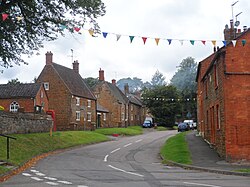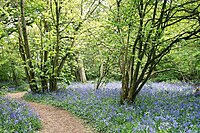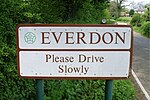Everdon
| Everdon | |
| Northamptonshire | |
|---|---|
 High Street, Everdon | |
| Location | |
| Grid reference: | SP595575 |
| Location: | 52°16’48"N, 1°9’36"W |
| Data | |
| Population: | 356 (2011) |
| Post town: | Daventry |
| Postcode: | NN11 |
| Dialling code: | 01327 |
| Local Government | |
| Council: | West Northamptonshire |
Everdon is a village in Northamptonshire, three miles south of Daventry. A little stream runs by the village which heads north, shortly to join the infant River Nene.
Nearby, The Stubbs is a wood belonging to the Woodland Trust. The village's former school is now an activities centre for conservation studies.
The population of the civil parish (including Little Everdon) at the 2011 census was 356.
To the north of Everdon is the hamlet of Little Everdon and to its south lies the shrunken village of Snorscombe.
St Mary's Church
Located at the centre of the village, Saint Mary's church dates from the 14th century, and was built in the decorated style. It has been suggested that an earlier structure may have sat at this site prior to the current building. The list of incumbents reveals that a rector, Eias Capellinus de Everdone, was appointed in 1218 and the font certainly predates the current church.
Local ironstone was used in the construction of the church, and it is believed that the Bernay Monks were involved in the work, importing their own stonemason from France to complete the work. The parts of the building still visible, which date from the 14th century, include the north doorway, the north aisle and east windows, which are detailed with unusual tracery.
The Rev. H. Cavalier, the rector of Great Brington in 1926, suggested that it was the churchyard of St Mary's, and not that of the Church of St Giles, Stoke Poges, that was the inspiration for Thomas Gray's famous elegy "In an English Churchyard". This theory suggested by, is based on observations comparing the two churchyards and the lines in the poem.
History
The village's name is from the Old English for Eofor dun, which means 'Wild boar hill'.[1]
The Domesday Book records that the manor belonged to the Bishop of Bayeux, recording land for 1 plough. 2 villains and 2 bordars and six acre of meadow.
In the Middle Ages, Everdon Priory was a small Benedictine priory, located at the eastern end of the village, close to a group of fish pools, which are still extant. It was a daughter house of the abbey of Bernay, in Normandy, and was granted lordship of the manor of Everdon. Like most alien priories, it was dissolved in 1415 under an Act of Henry V. In 1440 Henry VI granted the property of the priory to the newly founded Eton College, which established a manor house on the site.[2] A junior branch of the Spencer family from Badby took up the lease of the Eton College Manor house around 1500. The manor of Everdon should not be confused with the neighbouring manor of Little Everdon, where the Cluniac monks of Daventry Priory had a mill and land.[3]
The land was inclosed by Act of Parliament in 1764.
A charity school was established in Everdon in 1813, and in the same year an independent meeting house opened.
Everdon Stubbs
Everdon Stubbs is a deciduous woodland covering an area of approximately 100 acres and was once a famous hunting covert: the land now covered by the woods was originally grazing land for wild boar, from which Everdon gets its name.
In the spring the area is covered with its famous carpet of bluebells, extremely well known throughout the county. Everdon Stubbs is currently open to the public and has conservation work taking place on an ad-hoc basis.
Events
The Grand Fete is usually held on the last bank holiday Monday in August.
The Everdon Bonfire and Fireworks party began in 2006, raising funds for the church restoration fund.
To coincide with the bluebells of Everdon Stubbs in the spring, a team of village residents host the 'Bluebell Teas' in the village hall, with the hope that people visiting the woods will drop by.
Outside links
| ("Wikimedia Commons" has material about Everdon) |
References
- ↑ "Key to English Place-names". http://kepn.nottingham.ac.uk/map/place/Northamptonshire/Everdon.
- ↑ A History of the County of Northampton - Volume 2 p : Alien houses: The priory of Everdon (Victoria County History)
- ↑ A History of the County of Northampton - Volume 2 pp 109-114: Houses of Cluniac monks: The priory of St Augustine, Daventry (Victoria County History)

